Dental amalgam filling contain the element mercury. The safety of mercury in fillings has caused a controversy lasting for many years. Most of the concern involves whether constant exposure of mercury from the filling material in the mouth can have toxic effects on the body.
Unfortunately, most Americans are not knowledgeable about the mercury in dental fillings issue. As a result the public can be easily panicked by a TV broadcast, such as aired in 1990 by CBS news program 60 Minutes. Hal Huggins, a Colorado dentist and a critic of dental amalgams, shared his views on the 60 Minutes episode.
The purpose of this article is to give you the facts so you can make an intelligent decision about your health.
The amalgam filling was first introduced in France in the 1800s by the two Crawcour brothers. They then introduced it to the United States in 1833. It became popular and grew rapidly. Within 10 years about 50 percent of fillings placed were amalgam. At that time, it was composed of mercury and one other metal.
There are the pro and con mercury groups. Each group is very strong about their stance. The controversy began in 1840 when the American Society of Dental Surgeons (ASDS) co-founder Chapin Harris stated at a meeting about amalgam fillings: “It is one of the most objectionable articles for filling teeth that can be employed, and yet from the wonderful virtues ascribed to this pernicious compound by those who used it, thousands were induced to try it.”
In fact the ASDS members had to pledge not to use mercury fillings due to the fear of poisoning their patients. In the meantime, in 1859, another group of twenty-six dentists formed the American Dental Association (ADA). This group did not ban the use of mercury fillings, and has maintained that stance to today.
Until the 1970s The ADA maintained that mercury was bound in amalgam and did not release any vapor. At that time, studies reported small amounts of mercury vapor was being released from amalgam.
Today most are composed of approximately 50 percent mercury and 50 percent mixture of other metal powders that are made approximately of:
- 40 – 65 percent Silver
- 32 – 29 percent Tin
- 6 – 30 percent Copper
- 2 percent Zinc
- 3 percent Mercury
When the liquid mercury is mixed (triturated) with the powder, the result is a semi-hard substance. The dentist then has a few minutes to place this in the tooth before it hardens. Total hardening may take 24 hours.
The dental community is not the only one divided about the mercury issue. Even scientists have varying opinions on the matter. Most do agree that some mercury may leach into the mouth, but the amount and the effects it may have on the body vary. Most countries use amalgam as a filling choice, except Norway, Denmark and Sweden.
The environmental concerns are also considered for the negative side of mercury as a dental filling. According to the World Health Organization (WHO) mercury from amalgam fillings that are disposed of, accounts for 53 percent of total mercury emissions. Although some cities and states mandate regulations of mercury waste by dentists, it’s mostly unregulated.
The reason why it has been used for many years is that it’s durable with some lasting over 60 years. It’s fairly inexpensive and easy to use by the dentist. The pro-amalgam group also argue that Bisphenol A used in some brands of composite “white” fillings, has been shown to be a health concern. Bisphenol A has raised questions about being an endocrine disrupting chemical that mimics estrogen. This property could increase the risk of breast cancer.
The World Health Organization conducted a study to determine the amount of vapor levels over a 24-hour period in patients with at least nine amalgam fillings. They found the average daily dose of inhaled mercury vapor to be approximately 1 percent of the threshold limit established by WHO. But they also found the exposure can be increased by bruxism (grinding the teeth), chewing gum, brushing, chewing and eating.
Swedish and German studies found a correlation with the number of amalgam fillings and mercury levels in brain and kidney tissues. The National Institute of Dental Research (NIDR) study on amalgam on 1127 healthy males, found that each ten surface increase in amalgam exposure associated with an increase of mercury in urine concentration. However, none of the studies can accurately link the mercury levels to dental amalgams. This is another reason why the controversy continues, since the data has not been reproduced each time with the same results.
In 2004 Life Sciences Research Office tested the effects of mercury release from dental amalgam and how it affects systemic disease. They concluded that “the current data are insufficient to support an association between mercury release from dental amalgam and the various complaints that have been attributed to this restoration material.”
One side effect that scientists do agree on is an allergic reaction that some may report due to amalgam restorations. In Sweden and Germany, a study in 1991 – 1997 tested 3162 patients for allergy sensitivity to inorganic mercury.
Twenty-three percent or 719 patients were founds to have systemic allergic reaction. In 1991 the National Institute of Health (NIH) reported similar findings in a five-year study.
Two recent studies in 2006 on children, reported in Journal of American Dental Association (JAMA 295 (15) Bellinger, DC), indicated there was no statistically significant difference in adverse neuropsychological or renal effects over a five-year period. The anti-amalgam organization International Academy of Oral Medicine and Toxicology (IAOMT), argues that these studies are poorly designed and not accurate in their results.
The American Dental Association (ADA) has continuously maintained since 1859, that amalgam fillings are safe, except for the presence of allergy, which is rare. They have mandated that “the removal of amalgam restorations from the non-allergic patient for the alleged purpose of removing toxic substances from the body, when such treatment is performed solely at the recommendation or suggestion of the dentist, is improper and unethical.” A dentist license may be revoked if a patient is told to remove their amalgam fillings due to mercury.
Some practitioners recommend amalgam fillings be removed and replaced because they attribute symptoms to amalgam. For this reason, they may charge more than the usual and customary fees. They also believe that unprotected amalgam removal may cause more exposure to mercury vapor. Consumer Reports wrote in an article (1991. 56:316–9) “if a dentist wants to remove your fillings because they contain mercury, watch your wallet.”
Due to a large number of lawsuits by consumer organizations such as Consumers for Dental Choice, California has passed a bill that dental offices must issue a written warning to patients about mercury. They must also give patients written options for other types of fillings.
Today, dental amalgam is still one of the most commonly used materials for fillings. However, because of the continued controversy about it’s safety, other options have become available.
There are certainly other choices for fillings. Amalgam was the inexpensive counterpart of gold.
Today most dentists offer white “composite” fillings. These are synthetic resins that can be matched to tooth color. They are made of a mixture of powdered glass and plastic resin. The controversy about these types of fillings is that some may be manufactured with “Bis-GMA” based material that contain Bisphenol A, an endocrine disruptor that may contribute to breast cancer. The composites that are PEX-based materials do not mimic estrogen.
The positive side of composite restorations is that usually less tooth structure needs to be removed as compared to amalgam fillings. They are also more technique sensitive, cost more and vulnerable to “recurrent decay” due to micro-leakage.
Another option is “glass ionomers.” These are also tooth colored but not as natural looking as composites. They are not subject to micro-leakage, which is an advantage. Most contain and release fluoride for tooth decay prevention.
While composites, glass ionomers and amalgams are called “direct restorations,” there are other types of materials that require them being made in a laboratory. Porcelain is tooth colored but on a chewing tooth may easily fracture. Gold has been around longer than amalgam. It is very durable, cost more but for cosmetic reasons not preferred by many.
Through the years as demand for cosmetic dentistry has grown, these types of white fillings have become stronger.
In conclusion, it’s best to maintain healthy teeth and gums by eating a balanced diet, monitoring stress to prevent clenching and grinding the teeth, and practicing good home oral hygiene habits. Seeing your dentist regularly is also a must.











